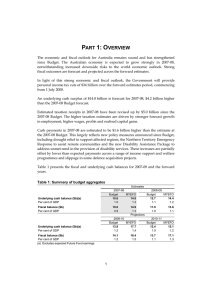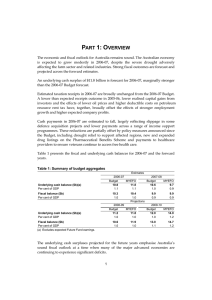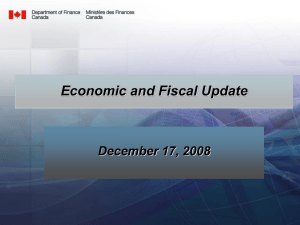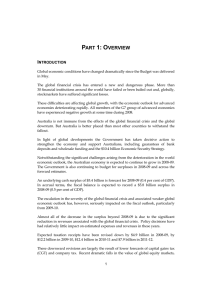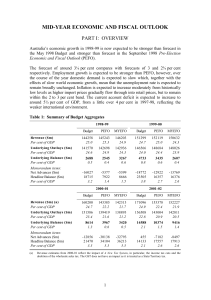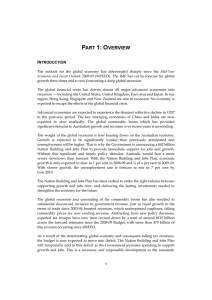P 1: O ART VERVIEW
advertisement
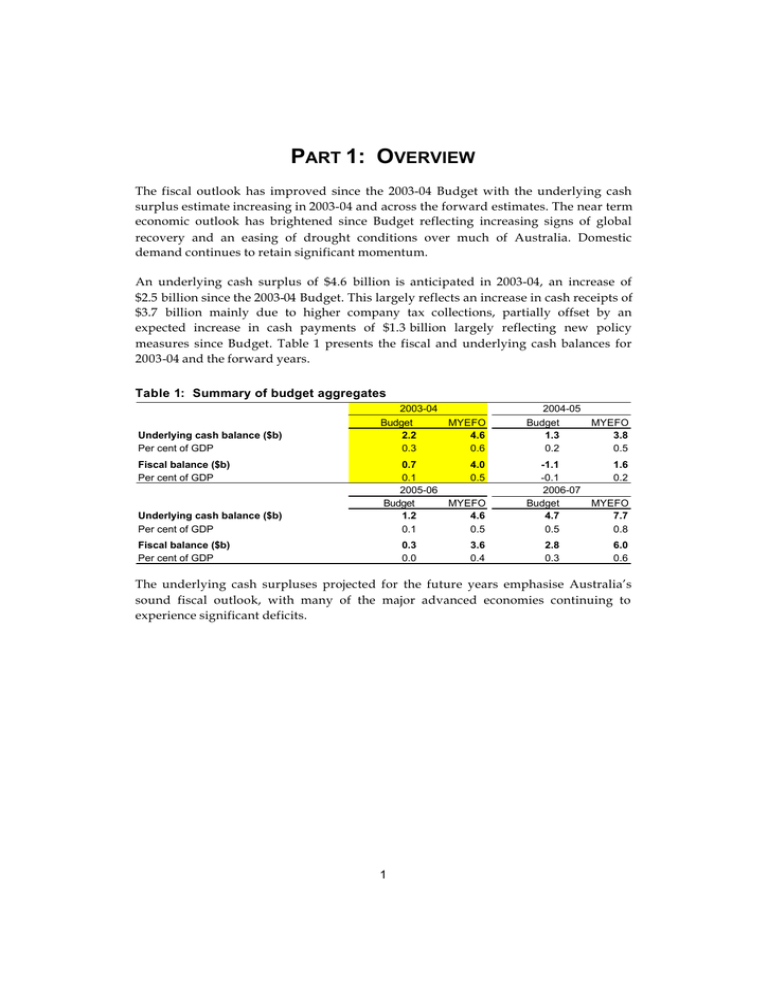
PART 1: OVERVIEW The fiscal outlook has improved since the 2003-04 Budget with the underlying cash surplus estimate increasing in 2003-04 and across the forward estimates. The near term economic outlook has brightened since Budget reflecting increasing signs of global recovery and an easing of drought conditions over much of Australia. Domestic demand continues to retain significant momentum. An underlying cash surplus of $4.6 billion is anticipated in 2003-04, an increase of $2.5 billion since the 2003-04 Budget. This largely reflects an increase in cash receipts of $3.7 billion mainly due to higher company tax collections, partially offset by an expected increase in cash payments of $1.3 billion largely reflecting new policy measures since Budget. Table 1 presents the fiscal and underlying cash balances for 2003-04 and the forward years. Table 1: Summary of budget aggregates Underlying cash balance ($b) Per cent of GDP Fiscal balance ($b) Per cent of GDP Underlying cash balance ($b) Per cent of GDP 2003-04 Budget 2.2 0.3 0.7 0.1 2005-06 Budget 1.2 0.1 Fiscal balance ($b) Per cent of GDP 0.3 0.0 MYEFO 4.6 0.6 4.0 0.5 MYEFO 4.6 0.5 3.6 0.4 2004-05 Budget 1.3 0.2 -1.1 -0.1 2006-07 Budget 4.7 0.5 2.8 0.3 MYEFO 3.8 0.5 1.6 0.2 MYEFO 7.7 0.8 6.0 0.6 The underlying cash surpluses projected for the future years emphasise Australia’s sound fiscal outlook, with many of the major advanced economies continuing to experience significant deficits. 1 Part 1: Overview Chart 1: International comparison of budget balances (a) 2004 and 2005 2.0 Per cent of GDP Per cent of GDP 1.0 2.0 1.0 0.0 03-04 04-05 -1.0 0.0 -1.0 -2.0 -2.0 -3.0 -3.0 -4.0 -4.0 -5.0 -5.0 -6.0 -6.0 -7.0 -7.0 -8.0 -8.0 Japan United States OECD European Union Australia (a) International data is for the total general government sector, sourced from OECD Economic Outlook (74) (preliminary edition, November 2003). Australian data is for the Australian Government general government sector. The increase in estimated total receipts of $3.7 billion in 2003-04 is largely driven by higher than expected receipts, particularly from tax on companies, reflecting the flow-on effect of the stronger than expected cash receipts for 2002-03 and evidence of continued strength in receipts in early 2003-04. The increase in estimated cash payments of $1.3 billion in 2003-04 is largely due to new policy measures. Major new policy measures include MedicarePlus, new listings on the Pharmaceutical Benefits Scheme, additional drought relief funding, and assistance in restoring law and order in the Solomon Islands. In accrual terms, the fiscal balance is expected to record a surplus of $4.0 billion in 2003-04, reflecting an increase of $3.3 billion since the 2003-04 Budget. The fiscal balance is expected to remain in surplus over the forward years. Further details on the accrual and cash budget estimates are provided in Part 3. DOMESTIC AND INTERNATIONAL ECONOMIC OUTLOOK The Australian economy is forecast to grow by 3¾ per cent in 2003-04, an upward revision from the 3¼ per cent forecast at the 2003-04 Budget. The upward revision comes against a backdrop of improving sentiment about domestic and external growth prospects. Generally, the near-term outlook for the Australian economy has brightened since Budget, with increasing signs of global recovery, particularly in the United States, and an easing in drought conditions over much of Australia. Near-term risks 2 Part 1: Overview around the outlook have diminished and are now more evenly balanced. However, some medium-term risks around both the domestic and international outlooks have become more pronounced. The key development in recent months has been the marked improvement in the near-term outlook for the global economy, with the pace of activity accelerating in the United States, and signs of recovery in Asia. Forecasts of world and major trading partner growth have been revised up since Budget. World and major trading partner growth is forecast to be 4 per cent in 2004. Nevertheless, there are a number of risks to the medium-term outlook, with various structural weaknesses and imbalances weighing on prospects for a sustained recovery. Offsetting the improved global outlook is the sharp appreciation of the $A exchange rate, which is likely to be a significant drag on the Australian economy over the next year. The expected rise in the terms of trade may provide a partial offset, but this initially boosts incomes and may take some time to be reflected in stronger activity. Domestic economic conditions are expected to remain robust. Domestic spending has continued to retain significant momentum, underpinned by low interest rates, solid income growth, high levels of confidence and steadily increasing wealth associated with rising house prices. This has provided useful support for the economy during a period of global weakness. However, borrowing against accumulating wealth has increased household debt. The risk of a substantial decline in dwelling investment and household consumption clouds an otherwise positive outlook. Drought conditions have eased across much of the country, providing a solid boost to the economy from a likely strong rebound in farm production. Employment growth is forecast to be 1½ per cent in 2003-04, and the unemployment rate is forecast to remain around, or a little below, current levels of 5¾ per cent over the next year. Inflation is expected to be moderate, falling to 2¼ per cent through the year to June 2004. Looking further ahead, the initial forecast for 2004-05 is for economic growth of around 3½ per cent, a little below the average of recent years. Ongoing global recovery and further increases in rural production should support the external sector. However, consumption growth may ease a little as the pace of wealth accumulation slows or as debt-servicing requirements increase. Dwelling investment is expected to fall as medium-density construction declines and business investment growth is expected to moderate as engineering construction eases from current high levels. Employment is likely to continue to grow steadily and the unemployment rate is expected to remain around, or a little below, current levels. Inflationary pressures should remain subdued, with inflation likely to be around, or a little below, 2 per cent in the year to June 2005. 3
